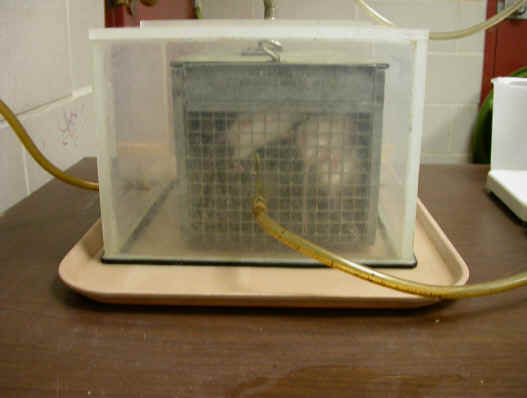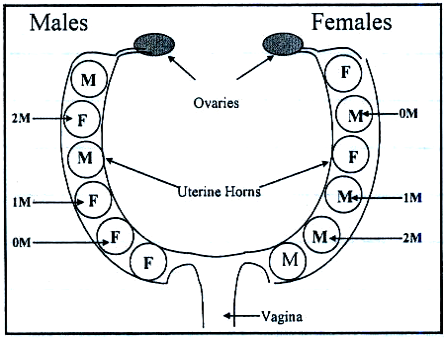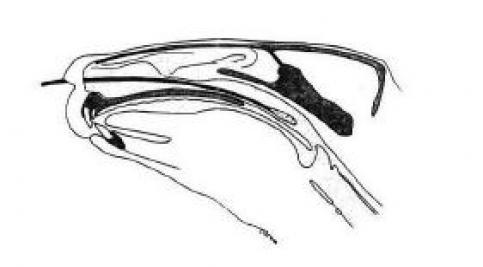Here are some of my current research interests.
The role of long-term exposure to cigarette smoke in the reduced pregnancy rate in Swiss Webster mice.
Cigarette smoking during pregnancy is responsible for an increase in the incidence of spontaneous abortions, stillbirths, neonatal mortality, and a significantly lower birth weight. In mice, long-term smoke exposure leads to a decrease in pregnancy rate. Preliminary data suggest that it may not be a failure in fertilization rate, but one of delayed or disrupted development. This project investigates the effects of long-term maternal exposure to cigarette smoke on the decreased pregnancy rate in mice. Embryos from smoked and control female Swiss Webster mice will be cultured from 24-hrs post coitus to assess the influence of maternal smoking on embryo morphology. The Uterine environment will also be examined by collecting uteri and histologically examining the tissues for signs of calcification. Placental development will also be accessed.

Smoking chamber for exposing mice to cigarette smoke.
Are Rabbits Susceptible to the Intrauterine Position Effect?
The intrauterine position of the developing fetus of litter-bearing species can have a profound effect on early development, effects that linger into adulthood. These effects appear to be related to the unique hormonal environment presented by surrounding fetuses. Female fetuses can be positioned between 2 male fetuses (2M), between one male and one female (1M) or between two females or have one female on one side and no fetus on the other side (0M). The same conditions can be described for male fetuses. Having males on either side of a female embryo subjects the female fetus to testosterone that can affect development.
The interactions between fetuses have been observed to have distinct effects on morphology, physiology and behavior in various species studied. The effects noted to date include: increased circulating testosterone in 2M female mice, increased weight gain for 2M male pigs, increased testosterone levels in 2M male Mongolian gerbils correlated with increase sizes of their ventral scent glands and their frequencies of scent markings, increased anogenital distance, urine marking and maternal aggression in 2M female mice, an increase in male sex ratio of offspring born to 2M female mice and gerbils, later estrus onset, shorter ovarian cycles and decreased lordosis in 2M females.
All of the effects noted in other litter-bearing species would be of economic importance to commercial rabbit production. As an example, the ability to alter the sex ratio would be a benefit to meat producers since males tend to gain faster and are more feed efficient. The above phenomenon could also explain the variability in production within a herd and presents another area of control for the rabbit producer.

A Role for 6-Methoxybenzoxazolinone on the Seasonal Breeding of Rabbits
Wild rabbits are seasonal breeders being reproductively active from early spring until late summer. Late in summer, does go through an anoestrus where follicular development ceases while during the same time the buck's testicles decrease in size, both leading to a decrease in reproductive activity. A similar, yet not as dramatic, seasonal effect on breeding has been reported in domestic rabbits as a decrease in fryer production during the fall and winter months.
The cause of the decreased production follows the change in day-length from longer days in spring and summer to shorter days in fall and winter. However, an attempt to overcome the seasonal depression in rabbit production by the use of artificial lighting has met mixed results. One reason for these results is that other factors, such as climate, type of light, the strain of rabbit, etc., may play a role or act in concert with the amount of light to produce these observations.
In other small herbivorous animals such as meadow voles, a similar seasonal breeding pattern is displayed. In the wild, reproduction in the winter when food supplies are limited would be selectively disadvantageous. While temperature and photoperiod may play a role in this winter depression, a plant compound 6-methoxybenzoxazolinone (6-MBOA) has been identified to act as an environmental cue stimulating reproductive activity in meadow voles.

The purpose of this research is to study the role of 6-methoxybenzoxazolinone (6-MBOA) a phenolic compound found in immature plant tissues, including sprouts. This compound is thought to stimulate the release of follicle stimulating hormone (FSH) of the endocrine system, which stimulates the development of Graafian follicles on the ovary thereby affecting the amount of endometrial tissue produced in the uterus. A preliminary trial using non-parous, sexually mature New Zealand White rabbits indicated a similar response as reported in meadow voles (Grobner, et al. 1985). Does receiving intraperitoneal injections of 6-MBOA had significantly heavier ovaries and uteri than the controls. The experimental does also exhibit proliferation of the uterine luminal epithelium. These effects correspond to the proposed mechanism of 6-MBOA acting as a melatonin agonist, blocking melatonin's inhibition of the release of luteinizing (LH) and follicle stimulating hormone (FSH). Melatonin is produced during periods of dark by the pineal gland and as day-length gets shorter, levels of melatonin production increase. Allowing the release of LH and FSH would stimulate ovarian development followed by an increase in ovarian production of estrogen leading to the uterine epithelial proliferation.
A rapid method of detecting Pasteurella multocida in rabbits from nasal swabs using PCR
Pasteurella multocida is a Gram-negative, nonmotile, facultative coccobacillus bacterium of considerable historic, economic and scientific importance. In rabbits, Pasteurella multocida has been implicated in pneumonia, otitis media, conjunctivitis, pyometra, orchitis, abscesses, and a generalized septicemia. These diseases are collectively referred to as Pasteurellosis. Pasteurellosis is considered one of the most important diseases in rabbits and is a leading cause of mortality and morbidity. Carrier rates among adult rabbits range from 30%-90% and it is generally agreed that Pasteurella multocida is universal among conventional rabbitries.
Current methods diagnosing pasteurellosis include nasal cultures, an ELISA (Enzyme-linked immunosorbent assay) test and the use of the Polymerase Chain Reaction (PCR) to detect DNA specific to P. multocida. Culture techniques entail taking a nasal or nasopharyngeal swab and culturing on blood agar. After incubation for 24-48 hours, these cultures are examined for suspected colonies of P. multocida. Suspect colonies are re-plated to obtain pure cultures and these cultures are subjected to biochemical tests to identify P. multocida. Testing can take 72 or more hours from the receipt of the swab before a definitive diagnosis can be made. In cases where P. multocida is present in low numbers, culturing may fail to detect its presence. In an attempt to overcome the limitations of culturing, an ELISA test (Enzyme-linked immunosorbent assay) was developed. The Elisa tests for the presence of antibodies to P. multocida in a blood sample taken from the animal to be tested. Infected animals will produce antibodies to P. multocidathat can be detected in the blood. While this test greatly reduces the time involved in testing, ELISA tests tend to be expensive and require extensive training in the technique. Another drawback to the ELISA is that it only detects antibodies to P. multocida and doesn't tell if the animal is actively infected or merely expressing antibodies to a previous infection. In other words, a rabbit once exposed to P. multocida will carry antibodies even when the infection has passed.
The most recent addition to techniques for diagnosing infection by P. multocida is the use of the Polymerase Chain Reaction (PCR) to detect the presence of DNA from P. multocida. The use of PCR provides a definitive diagnosis. The current use of PCR entails nasal or nasopharyngeal cultures to isolate bacteria to be tested. The suspected bacterial colonies are subjected to PCR amplification, which will increase the copies of DNA from a pre-determined template. If P. multocida is present, the DNA will be amplified to a concentration that can then be detected when the DNA is separated using gel electrophoresis. While being extremely specific, the current use requires the initial culture and the running of gel electrophoresis to visualize the DNA.

Illustration of the appropriate positioning of a calcium alginate swab for culturing the nasopharynx.
Updated: August 09, 2024